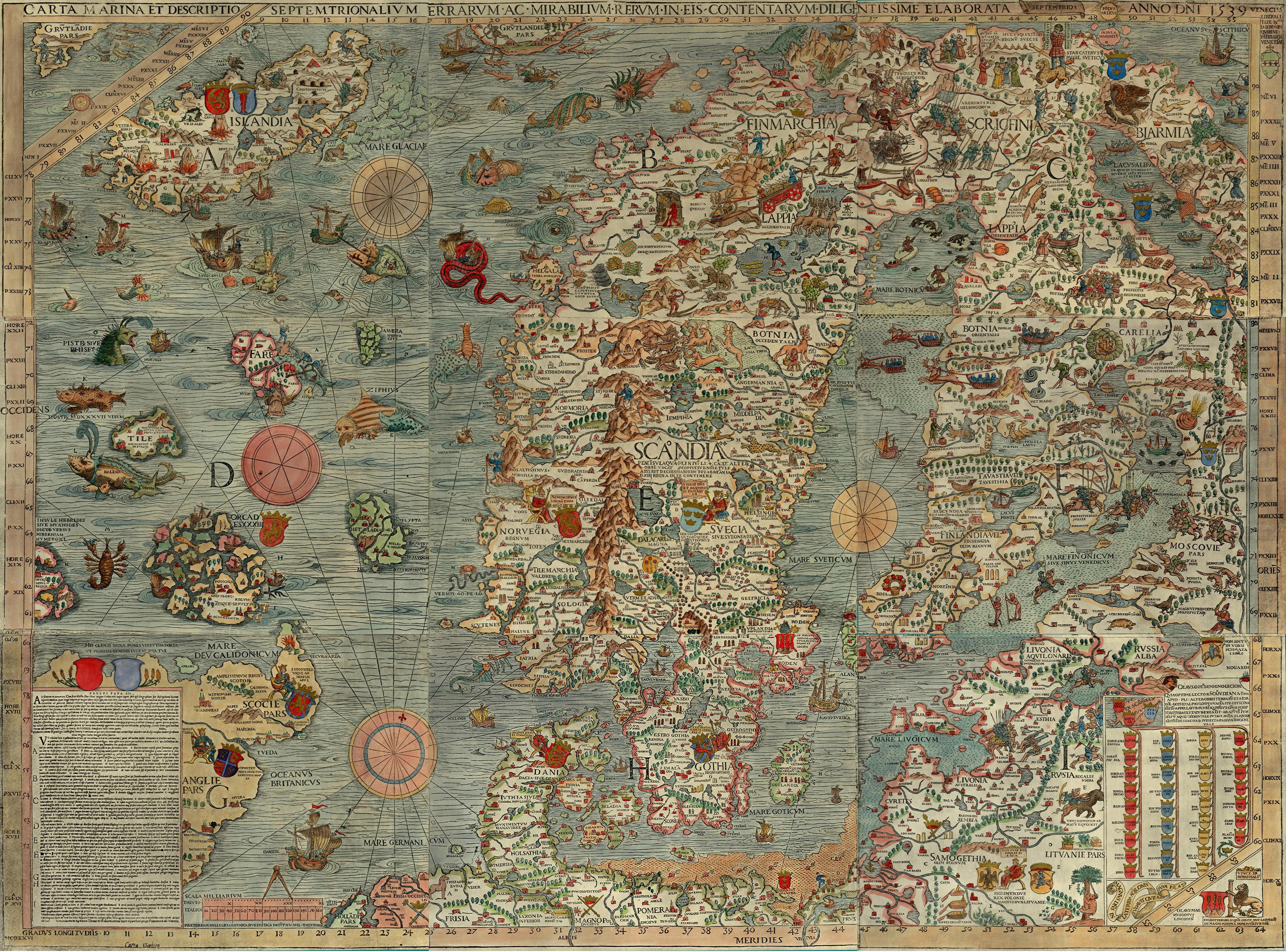
I've always had a fondness for the monsters from Medieval Bestiaries. So I decided to jot down my notes about various creatures from this type of source. Resources are primarily from several Medieval Bestiaries, lists of heraldic beasts, Jorge Luis Borges' Book of Imaginary Beings, Sebastian Münster’s Cosmographia, and the Carta Marina annotations. I've decided to leave out several of the more common or uninteresting beasts, such as Barnacle Goose, Basilisk, Bittern, Carbuncle, Centaur, Chimera, Cinnamologus, Cockatrice, Dipsa, Griffin,
Harpy, Hippocampus, Hippogriff, Hydra, Hypnalis, Incubus, Jormungandr, Kraken, Lamia, Leviathan, Mandrake/Mandragora, Manticore, Medusa, Mermaid, Minotaur, Orphan Bird, Pegasus, Peryton, Phoenix, Salamander, Sea-Lion/Merlion, Sea-Serpent, Senmurv, Siren, Simurgh, Sphinx, Sucubus, Unicorn, Vegetable Lamb (of Tartary), Wyvern, and Zilant. Also, I left off the Greek Cetus/Cetos/Ketos as there are varying descriptions and depictions of the creatures, and I've always felt that the better depictions are the Clash of the Titans' movie "krakens" and Altantis: The Lost Empire's "leviathan."
The Land of Nod blog has a series of articles that cover several of these creatures:
Medieval Bestiary
 Abarimon
Abarimon - A bestial, savage race of people who have backwards feet, yet can run at great speed.
 Afanc
Afanc - Welsh lake monster, also known as Addanc or Avanc, resembling a crocodile-beaver.
 Al Mi'raj
Al Mi'raj - An Arabic creature described as a yellow rabbit with a two foot long spiraling black horn projecting from its forehead. Known for being fiercely territorial and having a voracious appetite. Also called Miraj, Mi'raj, and Mir'aj.
 Alerion
Alerion - A heraldic large eagle, displayed without beak or talons. Also called Avalerion
 Allocamelus
Allocamelus - Heraldic "Ass-Camel," having the body of a camel with the head of a donkey (representing a llama).
 Alp
Alp - A Germanic shapeshifter, may be classified as fey (elf), undead (vampire or spirit), or demonic (incubus). More information at
Alp.
 Alphyn
Alphyn - Germanic Heraldic beast (from the German for "chaser" or "wolf"), this chimeric creature is a lion-wolf hybrid, depicted as a stocky quadreped with a white, airy body, thick, golden, tufted mane, long, thin tongue and triple knotted tail. It may have eagle or dragon talons on its forelegs, or the cloven, goat-like hooves. It may also be depicted with all four legs bearing lion's claws.
 Amphiptere
Amphiptere - Heraldic winged serpent. It is not a feathered serpent, having instead, bat-like wings and is usually green or greenish-yellow in coloration. Also called Amphithere, Amphitere, or Phipthere.
 Anthropophagus
Anthropophagus - Also known as androphagi ("man-eaters"), this race of people from Greek mythology were cannibals, sometimes confused with blemmyaes.
 Amphisbaena
Amphisbaena - Originally a snake with a head at each end of the body, by medieval times, it had morphed into a horned cockatrice with a snake-headed tail. Known for eating ants, it is also called "Mother of Ants." Also known as Amphisbaina, Amphisbene, Amphisboena, Amphisbona, Amphista, Amfivena, Amphisien Cockatrice, Amphivena, or Anphivena (the last two being feminine).
 Arimaspians
Arimaspians - A Greek mythical peoples, described as one-eyed men who battled griffins for their gold.
 Aspidochelone
Aspidochelone - A whale-turtle with huge spines on its back that is so large that it resembles an island, often developing sandy beaches, rocky crags and tree-filled valleys. While it produces a sweet scent to hunt the fish that are its prey, it is most notable for luring sailors to their doom. The typical tale of a ship's crew mooring to the "island" and then when they go to light fires for cooking, the creature dives deep into the water, taking the sailors and moored ship with it down to the depths. Also called Aspedocalane, Aspido testudo, Aspidoceleon, and Aspis chelone. Pliny the Elder identifies this creature as "pristis" (of immense size) which may related to Pristers (q.v.).
 Astomi
Astomi - Greek mythical peoples who consume pleasant scents, such as flowers or fruits instead of food or drink. They are depicted with hairy, rough bodies and no mouths and can be killed by smelling strong, unpleasant odors.
 Balena
Balena - Monstrous whales from cartographic maps, sometimes called Troll Whales or Devil Whales.
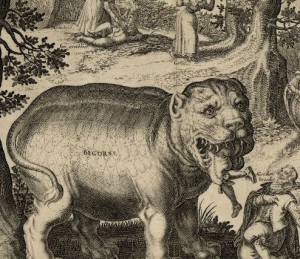 Bicorn
Bicorn - Also called Bicorne or Bulchin. While the name would indicate a creature with two horns, the depictions of this creature describe a fat, well-fed panther with a human face that feeds well on "hen-pecked husbands." It has an underfed counterpart known as a Chichevache which feeds onoly on "hen-pecked wives."
 Blemmyae
Blemmyae - A Greek mythocal race of headless men whose facial features could be found on their chests. Also known as Akephaloi ("headless ones"), with Epiphagi appearing as a variant name for those whose eyes could be found on their shoulders rather than on their chests.
 Bonnacon
Bonnacon - Mythical bull-like creature, with the mane of a horse, and horns that curl uselessly in to the degree that they provide no defense. Known for it's acidic or burning dung which can be fired as far as two acres. Also called Bonacon or Bonasus.
 Caladrius
Caladrius - Snow-white bird that can detect and possibly cure disease and illness.
 Calopus
Calopus - Roman variant of the antelope, "pretty foot." Appears as a roe deer with large saw-blade horns. Also called Aeternae, Analopos, Antalope, Antholops, Aptaleon, Aptolos, Jachamur, Jachmur, Jamur, Pantolops, and Yamur. Often confused with the Chatloup ("cat-wolf"), a wolf-bodied creature with the head of a cat and goat's horns.
 Calygreyhound
Calygreyhound - Heraldic beast described as having a cat's head with laurel-like antlers, an antelope body, eagle talons on its forelimbs with ox hooves on its hind limbs and a tufted tail like that of a lion or poodle.
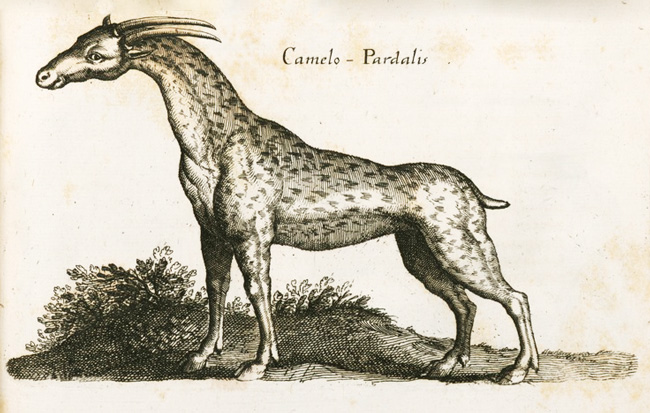 Camelopard
Camelopard - Heraldic depiction of a giraffe, described as a long-necked camel with the skin of a leopard. Also called Camelopardel, though this usually refers to a variant with swept-back horns.
 Catoblepas
Catoblepas - A scaled, heavily-maned buffalo with a wild boar's head that is so heavy its blood-shot eyes always points down. The stare or breath of the beast was believed to kill or petrify people.
 Cerastes
Cerastes - Spineless horned vipers from Greek mythology with two ram's horns or four smaller horns on their head. They hide in the sand with only their horns protruding in order to lure prey in close.
 Cercopes
Cercopes - Greek, tailed, forest creatures known for their knaveries and mischief.
 Choromandi
Choromandi - Hairy, savage people of Greek origin with dog's teeth that communicate in horrible screams instead of recognizable speech.
 Crocotta
Crocotta - Also known oas Corocotta or Crocuta, a dog-wolf or lion-hyena hybrid with a powerful jaw plate instead of teeth, believed to alternate sexes each year and self-impregnate. Also known for human-like speech which is uses to lure men out where it can devour them. Some magical abilities are attributed to them, such as being immune to weapons of steel, having great strength and being fleet of foot, or being able to paralyze dogs. Often confused with the similar Leucrotta, a chimera with the body and tail of a lion, a badger's head, stag's legs and cloven hoofs, and a mouth that replaces teeth with ridges of bones, though the ability to imitate human speech is the same.
 Cynocephali
Cynocephali - Dog- or jackal-headed humanoids originating from Greek myth. Also spelled Canocephalus.
 Echaneis
Echaneis - A remora-like fish that held ships in place by attaching themselves to the ship. Also called Echinius, Echinus, Enchirius, Essinus, Esynus , Remora, and Urchin.
 Enfield
Enfield - Heraldic chimera with the head of a fox, eagle's talons on the forelegs, a greyhound's chest, lion's body and hindlegs and tail of a wolf.
 Ethiopian Pegasus
Ethiopian Pegasus - Two-horned pegasi believed to hail from Ethiopia.
 Fastitocalon
Fastitocalon - Giant whale that is basically identical to the Aspidochelone, but not as turtle-like.
 Forest Bull
Forest Bull - Greek origin carnivorous red cattle, double normal size, with swiveling horns believed to hail from the forests of Ethiopia.
 Gegenees
Gegenees - Six armed giants from Greek mythology.
 Gorgades
Gorgades - Hair-covered female people from Greek sources that hail from Atlantic islands. May be related to the Satyrus.
 Hercinia
Hercinia - Also known as Ercinea or Harz Birds, these birds have brightly glowing feathers and hail from the Hercynian forest of Germany.
 Hippalectryon
Hippalectryon - A horse-rooster chimera from Greek mythology with the foreparts of a horse and the wings, tail, and hind legs of a rooster. Large enough to support a man-sized rider.
 Hippopodes
Hippopodes - Horse-footed mythical humanoids believed by the Greeks to live on islands in the Baltic Sea.
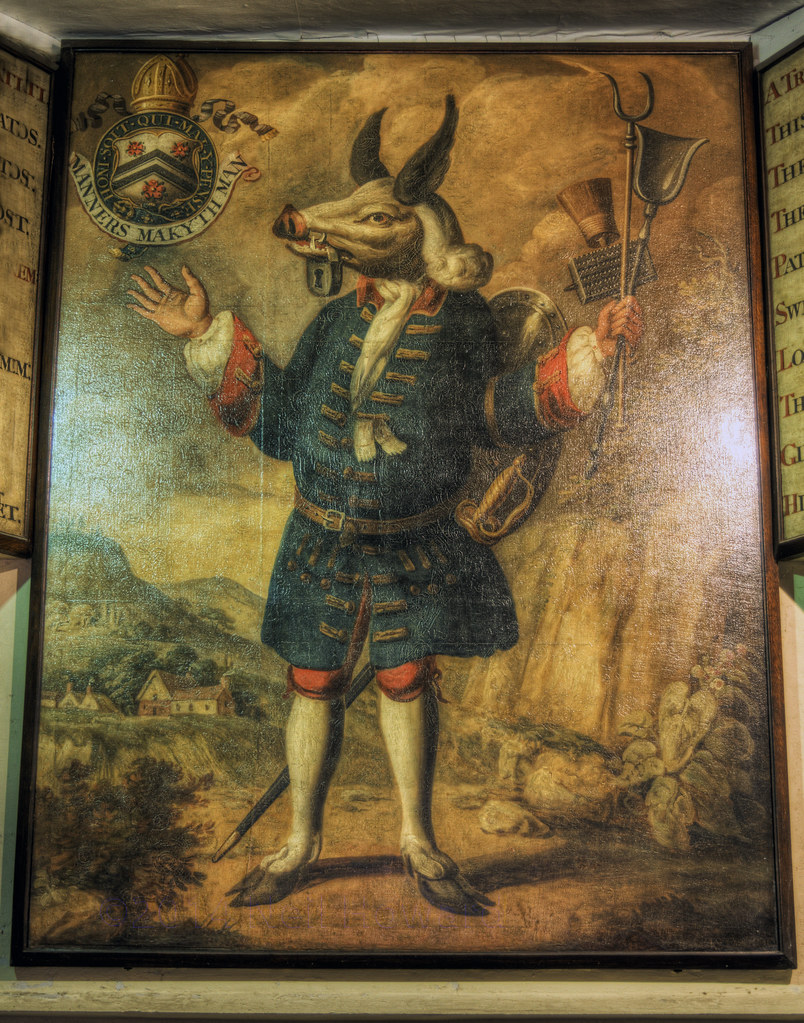 Hircocervus
Hircocervus - A goat-stag or horse-stag humanoid hybrid also known as Tragelaph.
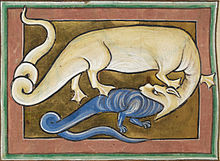 Hydrus
Hydrus - A serpentine, water dwelling creature with three heads hailing from the Nile, believed to pull a chest-bursting move on crocodiles which consumed them. Also called Enhydros, Enidros, Hildris, Hydra, Idra, Idres, Ydre, Ydris, and Ydrus.
 Ichneumon
Ichneumon - A dragon killing creature (which may also kill asps and crocodiles), the name, which translates from Greek as "tracker" is used for the snake-fighting mongoose. It is only described in that it covers itself with mud and closes its nostrils with its tail in order to be swallowed and thus attack dragons from the inside. This may relate the creature to the hydrus. The Latin translation of "tracker" or Calcatrix is where the cockatrice derives its name and the Ichneumon is one of the few creatures not effected by a cocaktrice's petrification ability. It is also called Echinemon.
 Ichthyocentaur
Ichthyocentaur - This fish-centaur hybrid was originally depicted as a hippocampus, but later became a dolphin-tailed humanoid with lion or horse forelegs; a look associated with some tritons.
 Jaculus
Jaculus - Also known as Iaculus, this winged serpent is commonly called, "Javelin Snake," due to its hunting tactic of hurling itself from trees into its prey. Generally seen as a bat-winged green snake, it also appears as a white-feathered two- or four-leged serpent with dragon-like characteristics.
 Jasconius
Jasconius - This island-sized fish is similar to the Aspidochelone or Fastitocalon, the only real difference is that it is depicted as fish rather than whale or turtle.
 Karkadann
Karkadann - A unicorn-like creature hailing from the deserts and plains of Persia. Commonly described as a buffalo with scaly, black skin, three yellow hooves on each foot, a lion's tail, and a conical horn protruding from the nose that is said to have medicinal properties (as an antidote to poison).
 Keythong
Keythong - A wingless griffin found in heraldic crests. Also known as Alce.
 Lampago
Lampago - Heraldic beast in the form of a man-tiger, with the body of a lion or tiger and man's face. Also called Lympago. It is similar to the manticore-like Satyral, a creature described as having the body of a lion, two ox-like or anteleope horns, the tail of an antelope, and an elderly man's bearded face.
 Leontophone
Leontophone - Small creature that is the enemy of lions either poisoning them while eaten, or being burned and having their ashes used to taint meat that is left out for lions.
 Libyan Aegipanes
Libyan Aegipanes - One of the many variant sub-species of satyrs. Satyrs themselves are basically goat-horned humanoids (with constant erections, that drink alot), occasionaly depicted as having the lower body of a goat as well, though this later association more properly defines the Roman Faun and the Greek Pan-like creatures known as Panes. Some confusion also exists with regards to the Sileni, horse-legged humanoids who later became conflated with the deity Silenus. Red-haired satyrs were known as Satyros Satyrides or the Latin Satyrus and hailed from remote Atlantic islands. Eithiopian Satyrs were considered violent, though they could be pacified with strong drink. Libyan Panes (occassionally called Libyan Satyrs) are typically depicted has having horse-like ears and tails, making them similar to Sileni.
 Lindworm
Lindworm - As a heraldic beast, lindworms are depicted as venomous, wingless, bipedal dragons. Norse depictions show a constricting sea serpent with glowing eyes in it's horse-like head with front claws (instead of a wyvern's hind claws).
 Machlyes
Machlyes - Greek mythical people hailing from Libya, described has having one side of their body with male characteristics and the other side having female characteristics.
 Macrocephali
Macrocephali - Tribe of African peoples accorded large or long heads by Greek sources.
 Melusine
Melusine - Fresh water mermaid with two (often serpentine) tails instead of one, ocassionaly depicted as having wings.
 Myrmecoleon
Myrmecoleon - The Ant-Lion, also called Formicaleon, Formicaleun, Mermecolion, and Mirmicioleon. Either a "Lion of Ants" or an ant with the body of a lion.
 Monoceros
Monoceros - Another unicorn variant, typically described as having a single, long, black horn projecting from its stag's head, a horse's body, elephant's feet, and boar's tail.
 Morhon
Morhon - This sea creature appears on maps and in heraldry as a whale with two blowholes and a leonine mane.
 Muscaliet
Muscaliet - A small creature with a hare's body, squirrel's legs and tail, weasel's ears, mole's muzzle, swine's bristly hair, and boar's tusks. They are said to generate so much heat that they burn their own nests.
 Musimon
Musimon - Also known as the Tityrus and Trytron, this heraldic beast has the body and legs of a goat, a ram's head, and four horns...two straight and two curved.
 Nebek
Nebek - A dog-like heraldic beast with a long, tufted tail, short tongue, and wrinkled snout.
 Nependis
Nependis - Heraldic beast with the upper body of an ape and the lower body of a boar, with a long, curling tail.
 Nuli
Nuli - A race of humanoids with backwards pointing, eight-toed feet.
 Onocentaur
Onocentaur - A human-donkey centaur. Also called Honocentar, Onoscentaurus, Uncor, Unocentaurus.
 Ophiotaurus
Ophiotaurus - Also known as the Serpent Bull, Stygian Bull, or Tauros Ophis, this creature has a black bull's head, body, and forelegs, with a serpent's tail.
 Opinicus
Opinicus - Heraldic variant of a griffin, with a lion's forelegs, camel's neck, and a camel's or bear's short tail.
 Orcha
Orcha - A sea monster from the Carta Marina. Also known as Orc*, Orca, and Orque. This whale-orc, complete with pig-faced and tusked snout appears prior to the Carta Marina in Ludovico Ariosto's
Orlando Furioso as well as Pliny the Elder's
Naturalis historia.
 Orthrus
Orthrus - Cerberus's two-headed brother.
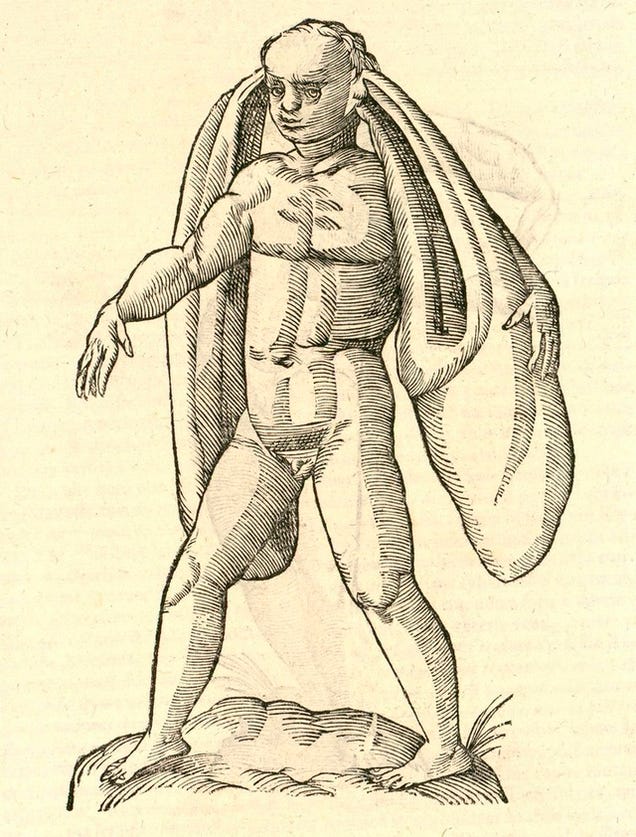 Pandi
Pandi - Greek mythical tribe with gigantic ears, eight fingers and toes, and white hair which turns black with age.
 Panotii
Panotii - A mythical peoples of Greek origin whose ears were so large that they forsake clothing, and could possibly fly with them.
 Pantheon
Pantheon - Heraldic beast with the body of a hind (black, dark blue, or red in color) spotted with mullets (straight pointed stars) or estoilles (wavy pointed stars), a fox's bushy tail, and cloven hooves.
 Parandrus
Parandrus - An ox-sized creature with shaggy, bear-like hair, deer's legs with cloven hooves, and a stag's head with branching antlers. It has the ability to change the color of it's skin like a chameleon. Also called Parander, Tarandos, Tarandrus, and Tharandus.
 Pard
Pard - Extremely fast feline creatures with spotted coats believed to mate with lions to produce leopards.
 Polypus
Polypus - Meaning "many-footed," this term is used to name giant lobsters and depictions of eight-legged, giant fish.
 Pristers
Pristers - Also called Physeter or Pristis, a whale sized creature with a mammalian face, horse's mane, and two blow holes which it uses to spout water at ships and sink them.
 Pygmies
Pygmies - A tribe of goat riding, Greek humanoids
pygme ("length of the forearm") tall, locked in battle with cranes.
 Questing Beast
Questing Beast - Chimeric monster of Arthurian legend that has the head and neck of a snake, body of a leopard, hindlegs of a lion, and the feet of a hart. Also known as the Beast Glatisant or Barking Beast.
 Quinotaur
Quinotaur - Sea creature from Frankish myth that resembles a hippocampus, but with the foreparts of a bull instead of horse, and an addition of three more horns forming a trident formation in the middle of the forehead.
 Rockas
Rockas - Gigantic rays known to rescue swimmers harassed by Sea-Dog-Fish.
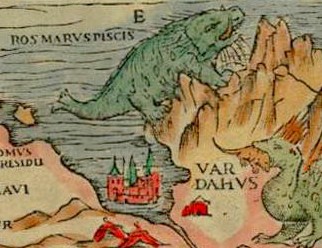 Rosmarus
Rosmarus - An amphibous "sea-elephant" that is more like a horse or dog combined with a walrus. It is a quadruped creature with clawed limbs, tusks, and a fish's tail.
 Satyrus
Satyrus - Also known as callitrix or cericopithicus. An ape species which bears twins, one of which the parent hates and the other that the parent loves.
 Scitalis
Scitalis - Also known as Scytalis or Scytale, this serpent has hypnotic markings on it's back which allows it to awe viewers, thus allowing it to strike. It is sometimes depicted with two front legs and its body heat is so great that it sheds skin even in winter.
 Sciritae
Sciritae - Greek mythical tribe from India who have snake-like nostrils instead of a nose, and bandy, serpentine legs. Also called Syrictae, Scritai or Skiritai.
 Sea-Bee
Sea-Bee - A heraldic beast composed of a bee with a fish tail.
 Sea Bishop or Sea Monk
Sea Bishop or Sea Monk - A fish that looks like a monk.
 Sea Goat
Sea Goat - Heraldic beast with the head and forelegs of a goat and a fish's tail.
 Sea Rhinoceros
Sea Rhinoceros - Fish-like creature with the head of a rhinoceros and a spotted pattern on it's hide.
 Sea Wolf
Sea Wolf - Heraldic beast with the head and forelegs of a wolf and a fish's tail.
 Sea Wyvern
Sea Wyvern - Heraldic wyvern with a fish's tail in place of a wyvern's barbed tail.
 Seps
Seps - Serpent with pointed ears and poison that liquifies its prey. Sometimes depicted with two or four legs.
 Serpopard
Serpopard - Chimeric creature with the body of a leopard or lion and the head and neck of a snake.
 Sha
Sha - Also called Set Animal, Typhonian Animal, and Typhonic Beast. This chimera consists of an aardvark's head, a jackal's body and front lets, a donkey's hindlimbs, and a forked reptilian tail that has triangular points.
 Sirrush
Sirrush - Messopotamian and Babylonian scaly dragon with hind legs resembling the talons of an eagle, lion forelegs, a long tail, a horned head, a snake-like tongue, and a crest. Also called Mushassu, Musussu, Mushhush, and Sirrusu.
 Skiapodes
Skiapodes - Also known as Monopods, Sciapods, and Skiapods. A mythical race of creatures with one large foot on one leg that used their large foot to as a sun shade or rain shield. They were beleived to hail from Eithiopia or India.
 Springhval
Springhval - Norwegian name for a whale fish with a sword-like dorsal fin, arm-like flippers, and a boar's snout and tusks that is a very fast swimmer. Also called Orca.
 Syrbotae
Syrbotae - Twelve foot tall giant peoples hailing from Africa in Greek mythology.
 Telchines
Telchines - Also spelled Telkhines. Malignant Greek magician creatures found on the islands of Keos and Rhodes with flippers for hands and dog's heads who were great metal-workers, having forged Chronos' Sickle and Poseidon's Trident. Their magical abilities include shapeshifting, being able to control weather, bringing about hail, snow or rain, fouling water, producing poisonous substances, causing crops to whither, and a hypnotic gaze.
 Theow
Theow - Wolf-like heraldic beast with cloven hooves, and a bovine muzzle and tail.
 Wiedergänger
Wiedergänger - Germanic revenant which may cause mischief or desire to avenge an injustice from when they were alive. May be related to Norse Draugr, headless riders, and vampires.
 Yale
Yale - Also known as Centicore, Eale, or Jall. A black, bull-like beast with a goat's head, the tusks of a boar and the tail of an elephant, notable for having two horns (which may appear straight or curved) that can swivel, with one generally kept pointing backwards so that it can bring that horn to bear if the other should be damaged. In heraldic depictions, it often has a goat's body and a pattern of multi-colored spots. There are also some additional variants, such as an antelope's body, horse's body, ears, mouth, and/or tail, tawny fur, a tufted lion's tail, a bear's snout, lion's face, bear's face, cloven feet, or pawed feet. It is the enemy of the basilisk.
 Yppotryll
Yppotryll - Heraldic beast with the body and humps of a camel, tusked boar's head, cloven hooves, and a serpent's tail. Also called Hippotryll or Ypotryll.
 Zaratan
Zaratan - Likely just the Middle Eastern name of the Aspidochelone, this creature, an island turtle, appears in The Book of Imaginary Beings and is likely the name for the island whale encountered in Sinbad the Sailor's First Voyage.
 Ziphius
Ziphius - Large fish- or whale-like sea monster with a sword-like dorsal fin which it uses to attack ships, and an owl's face. It feeds primarily on black seals.
*The Tolkienesque Orc appears to derive from the words orcþyrs or orcneas, related to the term orco (ogre), ultimately believed to be derived from the Roman Orcus. This type of "Orc" also appears in Orlando Furioso, as a blind, cannibalistic giant that cannot be killed.
 Al Mi'raj - An Arabic creature described as a yellow rabbit with a two foot long spiraling black horn projecting from its forehead. Known for being fiercely territorial and having a voracious appetite. Also called Miraj, Mi'raj, and Mir'aj.
Al Mi'raj - An Arabic creature described as a yellow rabbit with a two foot long spiraling black horn projecting from its forehead. Known for being fiercely territorial and having a voracious appetite. Also called Miraj, Mi'raj, and Mir'aj. Allocamelus - Heraldic "Ass-Camel," having the body of a camel with the head of a donkey (representing a llama).
Allocamelus - Heraldic "Ass-Camel," having the body of a camel with the head of a donkey (representing a llama). Alp - A Germanic shapeshifter, may be classified as fey (elf), undead (vampire or spirit), or demonic (incubus). More information at Alp.
Alp - A Germanic shapeshifter, may be classified as fey (elf), undead (vampire or spirit), or demonic (incubus). More information at Alp. Astomi - Greek mythical peoples who consume pleasant scents, such as flowers or fruits instead of food or drink. They are depicted with hairy, rough bodies and no mouths and can be killed by smelling strong, unpleasant odors.
Astomi - Greek mythical peoples who consume pleasant scents, such as flowers or fruits instead of food or drink. They are depicted with hairy, rough bodies and no mouths and can be killed by smelling strong, unpleasant odors. Balena - Monstrous whales from cartographic maps, sometimes called Troll Whales or Devil Whales.
Balena - Monstrous whales from cartographic maps, sometimes called Troll Whales or Devil Whales. Bicorn - Also called Bicorne or Bulchin. While the name would indicate a creature with two horns, the depictions of this creature describe a fat, well-fed panther with a human face that feeds well on "hen-pecked husbands." It has an underfed counterpart known as a Chichevache which feeds onoly on "hen-pecked wives."
Bicorn - Also called Bicorne or Bulchin. While the name would indicate a creature with two horns, the depictions of this creature describe a fat, well-fed panther with a human face that feeds well on "hen-pecked husbands." It has an underfed counterpart known as a Chichevache which feeds onoly on "hen-pecked wives." Bonnacon - Mythical bull-like creature, with the mane of a horse, and horns that curl uselessly in to the degree that they provide no defense. Known for it's acidic or burning dung which can be fired as far as two acres. Also called Bonacon or Bonasus.
Bonnacon - Mythical bull-like creature, with the mane of a horse, and horns that curl uselessly in to the degree that they provide no defense. Known for it's acidic or burning dung which can be fired as far as two acres. Also called Bonacon or Bonasus. Camelopard - Heraldic depiction of a giraffe, described as a long-necked camel with the skin of a leopard. Also called Camelopardel, though this usually refers to a variant with swept-back horns.
Camelopard - Heraldic depiction of a giraffe, described as a long-necked camel with the skin of a leopard. Also called Camelopardel, though this usually refers to a variant with swept-back horns. Catoblepas - A scaled, heavily-maned buffalo with a wild boar's head that is so heavy its blood-shot eyes always points down. The stare or breath of the beast was believed to kill or petrify people.
Catoblepas - A scaled, heavily-maned buffalo with a wild boar's head that is so heavy its blood-shot eyes always points down. The stare or breath of the beast was believed to kill or petrify people. Cercopes - Greek, tailed, forest creatures known for their knaveries and mischief.
Cercopes - Greek, tailed, forest creatures known for their knaveries and mischief. Choromandi - Hairy, savage people of Greek origin with dog's teeth that communicate in horrible screams instead of recognizable speech.
Choromandi - Hairy, savage people of Greek origin with dog's teeth that communicate in horrible screams instead of recognizable speech. Fastitocalon - Giant whale that is basically identical to the Aspidochelone, but not as turtle-like.
Fastitocalon - Giant whale that is basically identical to the Aspidochelone, but not as turtle-like. Hercinia - Also known as Ercinea or Harz Birds, these birds have brightly glowing feathers and hail from the Hercynian forest of Germany.
Hercinia - Also known as Ercinea or Harz Birds, these birds have brightly glowing feathers and hail from the Hercynian forest of Germany. Hircocervus - A goat-stag or horse-stag humanoid hybrid also known as Tragelaph.
Hircocervus - A goat-stag or horse-stag humanoid hybrid also known as Tragelaph. Hydrus - A serpentine, water dwelling creature with three heads hailing from the Nile, believed to pull a chest-bursting move on crocodiles which consumed them. Also called Enhydros, Enidros, Hildris, Hydra, Idra, Idres, Ydre, Ydris, and Ydrus.
Hydrus - A serpentine, water dwelling creature with three heads hailing from the Nile, believed to pull a chest-bursting move on crocodiles which consumed them. Also called Enhydros, Enidros, Hildris, Hydra, Idra, Idres, Ydre, Ydris, and Ydrus. Jasconius - This island-sized fish is similar to the Aspidochelone or Fastitocalon, the only real difference is that it is depicted as fish rather than whale or turtle.
Jasconius - This island-sized fish is similar to the Aspidochelone or Fastitocalon, the only real difference is that it is depicted as fish rather than whale or turtle. Lampago - Heraldic beast in the form of a man-tiger, with the body of a lion or tiger and man's face. Also called Lympago. It is similar to the manticore-like Satyral, a creature described as having the body of a lion, two ox-like or anteleope horns, the tail of an antelope, and an elderly man's bearded face.
Lampago - Heraldic beast in the form of a man-tiger, with the body of a lion or tiger and man's face. Also called Lympago. It is similar to the manticore-like Satyral, a creature described as having the body of a lion, two ox-like or anteleope horns, the tail of an antelope, and an elderly man's bearded face. Libyan Aegipanes - One of the many variant sub-species of satyrs. Satyrs themselves are basically goat-horned humanoids (with constant erections, that drink alot), occasionaly depicted as having the lower body of a goat as well, though this later association more properly defines the Roman Faun and the Greek Pan-like creatures known as Panes. Some confusion also exists with regards to the Sileni, horse-legged humanoids who later became conflated with the deity Silenus. Red-haired satyrs were known as Satyros Satyrides or the Latin Satyrus and hailed from remote Atlantic islands. Eithiopian Satyrs were considered violent, though they could be pacified with strong drink. Libyan Panes (occassionally called Libyan Satyrs) are typically depicted has having horse-like ears and tails, making them similar to Sileni.
Libyan Aegipanes - One of the many variant sub-species of satyrs. Satyrs themselves are basically goat-horned humanoids (with constant erections, that drink alot), occasionaly depicted as having the lower body of a goat as well, though this later association more properly defines the Roman Faun and the Greek Pan-like creatures known as Panes. Some confusion also exists with regards to the Sileni, horse-legged humanoids who later became conflated with the deity Silenus. Red-haired satyrs were known as Satyros Satyrides or the Latin Satyrus and hailed from remote Atlantic islands. Eithiopian Satyrs were considered violent, though they could be pacified with strong drink. Libyan Panes (occassionally called Libyan Satyrs) are typically depicted has having horse-like ears and tails, making them similar to Sileni. Machlyes - Greek mythical people hailing from Libya, described has having one side of their body with male characteristics and the other side having female characteristics.
Machlyes - Greek mythical people hailing from Libya, described has having one side of their body with male characteristics and the other side having female characteristics. Nependis - Heraldic beast with the upper body of an ape and the lower body of a boar, with a long, curling tail.
Nependis - Heraldic beast with the upper body of an ape and the lower body of a boar, with a long, curling tail. Orcha - A sea monster from the Carta Marina. Also known as Orc*, Orca, and Orque. This whale-orc, complete with pig-faced and tusked snout appears prior to the Carta Marina in Ludovico Ariosto's Orlando Furioso as well as Pliny the Elder's Naturalis historia.
Orcha - A sea monster from the Carta Marina. Also known as Orc*, Orca, and Orque. This whale-orc, complete with pig-faced and tusked snout appears prior to the Carta Marina in Ludovico Ariosto's Orlando Furioso as well as Pliny the Elder's Naturalis historia. Pandi - Greek mythical tribe with gigantic ears, eight fingers and toes, and white hair which turns black with age.
Pandi - Greek mythical tribe with gigantic ears, eight fingers and toes, and white hair which turns black with age.  Pard - Extremely fast feline creatures with spotted coats believed to mate with lions to produce leopards.
Pard - Extremely fast feline creatures with spotted coats believed to mate with lions to produce leopards. Pristers - Also called Physeter or Pristis, a whale sized creature with a mammalian face, horse's mane, and two blow holes which it uses to spout water at ships and sink them.
Pristers - Also called Physeter or Pristis, a whale sized creature with a mammalian face, horse's mane, and two blow holes which it uses to spout water at ships and sink them. Rockas - Gigantic rays known to rescue swimmers harassed by Sea-Dog-Fish.
Rockas - Gigantic rays known to rescue swimmers harassed by Sea-Dog-Fish. Rosmarus - An amphibous "sea-elephant" that is more like a horse or dog combined with a walrus. It is a quadruped creature with clawed limbs, tusks, and a fish's tail.
Rosmarus - An amphibous "sea-elephant" that is more like a horse or dog combined with a walrus. It is a quadruped creature with clawed limbs, tusks, and a fish's tail. Satyrus - Also known as callitrix or cericopithicus. An ape species which bears twins, one of which the parent hates and the other that the parent loves.
Satyrus - Also known as callitrix or cericopithicus. An ape species which bears twins, one of which the parent hates and the other that the parent loves. Scitalis - Also known as Scytalis or Scytale, this serpent has hypnotic markings on it's back which allows it to awe viewers, thus allowing it to strike. It is sometimes depicted with two front legs and its body heat is so great that it sheds skin even in winter.
Scitalis - Also known as Scytalis or Scytale, this serpent has hypnotic markings on it's back which allows it to awe viewers, thus allowing it to strike. It is sometimes depicted with two front legs and its body heat is so great that it sheds skin even in winter. Sciritae - Greek mythical tribe from India who have snake-like nostrils instead of a nose, and bandy, serpentine legs. Also called Syrictae, Scritai or Skiritai.
Sciritae - Greek mythical tribe from India who have snake-like nostrils instead of a nose, and bandy, serpentine legs. Also called Syrictae, Scritai or Skiritai. Sea Bishop or Sea Monk - A fish that looks like a monk.
Sea Bishop or Sea Monk - A fish that looks like a monk. Sea Rhinoceros - Fish-like creature with the head of a rhinoceros and a spotted pattern on it's hide.
Sea Rhinoceros - Fish-like creature with the head of a rhinoceros and a spotted pattern on it's hide. Seps - Serpent with pointed ears and poison that liquifies its prey. Sometimes depicted with two or four legs.
Seps - Serpent with pointed ears and poison that liquifies its prey. Sometimes depicted with two or four legs. Springhval - Norwegian name for a whale fish with a sword-like dorsal fin, arm-like flippers, and a boar's snout and tusks that is a very fast swimmer. Also called Orca.
Springhval - Norwegian name for a whale fish with a sword-like dorsal fin, arm-like flippers, and a boar's snout and tusks that is a very fast swimmer. Also called Orca. Yale - Also known as Centicore, Eale, or Jall. A black, bull-like beast with a goat's head, the tusks of a boar and the tail of an elephant, notable for having two horns (which may appear straight or curved) that can swivel, with one generally kept pointing backwards so that it can bring that horn to bear if the other should be damaged. In heraldic depictions, it often has a goat's body and a pattern of multi-colored spots. There are also some additional variants, such as an antelope's body, horse's body, ears, mouth, and/or tail, tawny fur, a tufted lion's tail, a bear's snout, lion's face, bear's face, cloven feet, or pawed feet. It is the enemy of the basilisk.
Yale - Also known as Centicore, Eale, or Jall. A black, bull-like beast with a goat's head, the tusks of a boar and the tail of an elephant, notable for having two horns (which may appear straight or curved) that can swivel, with one generally kept pointing backwards so that it can bring that horn to bear if the other should be damaged. In heraldic depictions, it often has a goat's body and a pattern of multi-colored spots. There are also some additional variants, such as an antelope's body, horse's body, ears, mouth, and/or tail, tawny fur, a tufted lion's tail, a bear's snout, lion's face, bear's face, cloven feet, or pawed feet. It is the enemy of the basilisk. Zaratan - Likely just the Middle Eastern name of the Aspidochelone, this creature, an island turtle, appears in The Book of Imaginary Beings and is likely the name for the island whale encountered in Sinbad the Sailor's First Voyage.
Zaratan - Likely just the Middle Eastern name of the Aspidochelone, this creature, an island turtle, appears in The Book of Imaginary Beings and is likely the name for the island whale encountered in Sinbad the Sailor's First Voyage. Ziphius - Large fish- or whale-like sea monster with a sword-like dorsal fin which it uses to attack ships, and an owl's face. It feeds primarily on black seals.
Ziphius - Large fish- or whale-like sea monster with a sword-like dorsal fin which it uses to attack ships, and an owl's face. It feeds primarily on black seals.
No comments:
Post a Comment